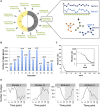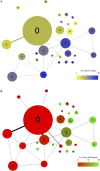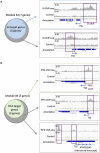Co-expression Networks From Gene Expression Variability Between Genetically Identical Seedlings Can Reveal Novel Regulatory Relationships
- PMID: 33384705
- PMCID: PMC7770228
- DOI: 10.3389/fpls.2020.599464
Co-expression Networks From Gene Expression Variability Between Genetically Identical Seedlings Can Reveal Novel Regulatory Relationships
Abstract
Co-expression networks are a powerful tool to understand gene regulation. They have been used to identify new regulation and function of genes involved in plant development and their response to the environment. Up to now, co-expression networks have been inferred using transcriptomes generated on plants experiencing genetic or environmental perturbation, or from expression time series. We propose a new approach by showing that co-expression networks can be constructed in the absence of genetic and environmental perturbation, for plants at the same developmental stage. For this, we used transcriptomes that were generated from genetically identical individual plants that were grown under the same conditions and for the same amount of time. Twelve time points were used to cover the 24-h light/dark cycle. We used variability in gene expression between individual plants of the same time point to infer a co-expression network. We show that this network is biologically relevant and use it to suggest new gene functions and to identify new targets for the transcriptional regulators GI, PIF4, and PRR5. Moreover, we find different co-regulation in this network based on changes in expression between individual plants, compared to the usual approach requiring environmental perturbation. Our work shows that gene co-expression networks can be identified using variability in gene expression between individual plants, without the need for genetic or environmental perturbations. It will allow further exploration of gene regulation in contexts with subtle differences between plants, which could be closer to what individual plants in a population might face in the wild.
Keywords: Arabidopsis; co-expression analysis; gene expression; modules; networks; seedlings; variability.
Copyright © 2020 Cortijo, Bhattarai, Locke and Ahnert.
Conflict of interest statement
The authors declare that the research was conducted in the absence of any commercial or financial relationships that could be construed as a potential conflict of interest.
Figures





Similar articles
-
Expression-based network biology identifies immune-related functional modules involved in plant defense.BMC Genomics. 2014 Jun 3;15:421. doi: 10.1186/1471-2164-15-421. BMC Genomics. 2014. PMID: 24888606 Free PMC article.
-
Discovery of core biotic stress responsive genes in Arabidopsis by weighted gene co-expression network analysis.PLoS One. 2015 Mar 2;10(3):e0118731. doi: 10.1371/journal.pone.0118731. eCollection 2015. PLoS One. 2015. PMID: 25730421 Free PMC article.
-
Identification of regulatory modules in genome scale transcription regulatory networks.BMC Syst Biol. 2017 Dec 15;11(1):140. doi: 10.1186/s12918-017-0493-2. BMC Syst Biol. 2017. PMID: 29246163 Free PMC article.
-
From gene to biomolecular networks: a review of evidences for understanding complex biological function in plants.Curr Opin Biotechnol. 2022 Apr;74:66-74. doi: 10.1016/j.copbio.2021.10.023. Epub 2021 Nov 17. Curr Opin Biotechnol. 2022. PMID: 34800849 Review.
-
PIF4 Integrates Multiple Environmental and Hormonal Signals for Plant Growth Regulation in Arabidopsis.Mol Cells. 2016 Aug 31;39(8):587-93. doi: 10.14348/molcells.2016.0126. Epub 2016 Jul 19. Mol Cells. 2016. PMID: 27432188 Free PMC article. Review.
Cited by
-
Predicting yield of individual field-grown rapeseed plants from rosette-stage leaf gene expression.PLoS Comput Biol. 2023 May 30;19(5):e1011161. doi: 10.1371/journal.pcbi.1011161. eCollection 2023 May. PLoS Comput Biol. 2023. PMID: 37253069 Free PMC article.
-
Design, execution, and interpretation of plant RNA-seq analyses.Front Plant Sci. 2023 Jun 30;14:1135455. doi: 10.3389/fpls.2023.1135455. eCollection 2023. Front Plant Sci. 2023. PMID: 37457354 Free PMC article. Review.
-
Integrated Systems Biology Pipeline to Compare Co-Expression Networks in Plants and Elucidate Differential Regulators.Plants (Basel). 2023 Oct 19;12(20):3618. doi: 10.3390/plants12203618. Plants (Basel). 2023. PMID: 37896081 Free PMC article.
-
Network Analysis Reveals Different Cellulose Degradation Strategies Across Trichoderma harzianum Strains Associated With XYR1 and CRE1.Front Genet. 2022 Feb 24;13:807243. doi: 10.3389/fgene.2022.807243. eCollection 2022. Front Genet. 2022. PMID: 35281818 Free PMC article.
-
Effects of light regimes on circadian gene co-expression networks in Arabidopsis thaliana.Plant Direct. 2024 Aug 26;8(8):e70001. doi: 10.1002/pld3.70001. eCollection 2024 Aug. Plant Direct. 2024. PMID: 39669405 Free PMC article.
References
-
- Blondel V. D., Guillaume J.-L., Lambiotte R., Lefebvre E. (2008). Fast unfolding of communities in large networks. J. Stat. Mech. 2008:10008 10.1088/1742-5468/2008/10/P10008 - DOI
LinkOut - more resources
Full Text Sources
Molecular Biology Databases

